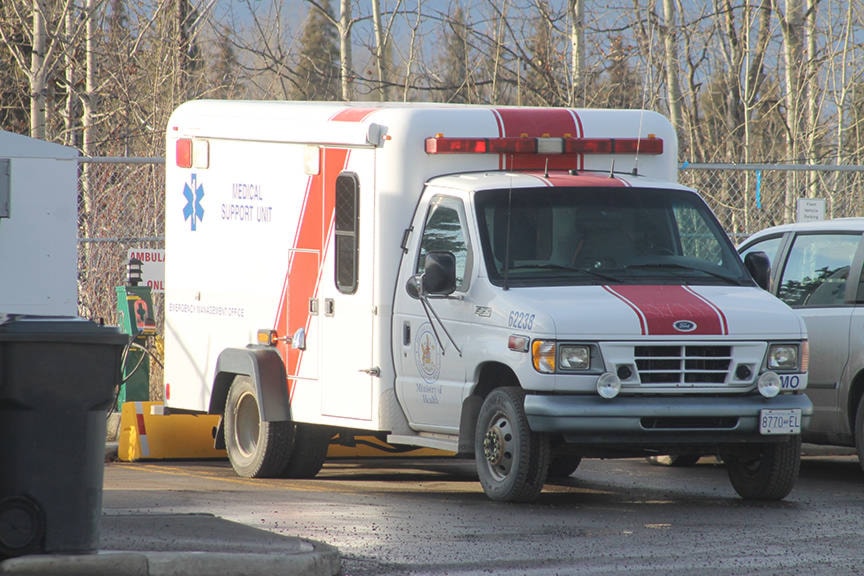Burns Lake has one of the few four-wheel drive ambulances in the province but the British Columbia Emergency Health Services (BCEHS) doesn’t plan to add more to its fleet.
The idea of adding more four-wheel drive ambulances was raised by the neighbouring District of Houston council, which asked the provincial Ministry of Health that the vehicles be provided.
READ MORE: No four-wheel drive ambulances for the north
“It is a major safety risk that our emergency services vehicles may be unequipped to reach patients or hospital destinations in other communities in adverse weather conditions,” the council stated in a briefing note prepared for health minister Adrian Dix.
“Many elderly residents may be unable to regularly shovel snow from their driveways, meaning that ambulances may have restricted access to private residences,” the note added.
Burns Lake’s ambulance is one of the nine four-wheel drive vehicles in the fleet, as BCEHS spokesperson Shannon Miller told Lakes District News. The Chevrolet Silverado 4x4 is also one of the most used based on its kilometre accumulation and paramedics have reviewed it positively.
However, Miller said the ambulance “is not any further help to crews in icy conditions” and in general the BCEHS has found the four-wheel drive vehicles unsatisfactory.
“The primary reason the trial was not expanded is the 4x4 ambulances presented a safety risk for our paramedics,” she said.
“The nature of a 4x4 ambulance means an increased floor height, significantly increasing the risk of injury while loading and unloading the ambulance. Musculoskeletal injuries are by far the leading cause of injury for paramedics.”
Paramedics also found the 4x4 chassis to have a much stiffer and rougher riding suspension, affecting the comfort of patients inside the vehicles.
But for Hans Dysarsz, an emergency medical care advocate, Miller’s response misses the mark.
“It’s ridiculous to say a 4x4 is a rougher ride. Anyone who says that hasn’t ridden in a four-wheel drive vehicle,” said Dysarsz, who is the Executive Director of B.C. HEROS (Helicopter Emergency Rescue Operations Society).
Dysarsz believes that the decision-making behind vehicle procurement and the current fleet of ambulances in the province are unacceptable.
“The ambulance service in B.C. should do a critical mission definition and consider what the worst day is in a year? How to reach 300 people in critical condition on a snow day? Up north you’re paying taxes for services that only people on the southern mainland can access. To say that ambulances that are suited for the conditions of southern California are good for the north dosn’t make sense,” he explained.
“In Victoria they’re asking paramedics and ambulance staff to perform miracles without giving them the proper equipment. By not giving them the right equipment to reach patients and bring them back to the hospital, they’re putting patients at risk.”
He proposes that the province invest in Unimog ambulances, an all-wheel drive truck used for military, agricultural and construction purposes.
“This vehicle has been the backbone of European ambulances for 50 years,” Dysarsz said.
The Unimogs are fast, their large tires help absorb shock on rough roads and the longer wheel base gives them a smooth ride.
Dysarsz said they would function well in heavy snow because they have plows on their fronts and can drive through deep snow.
Their hardiness also equips them for driving up forestry roads, which current ambulances in B.C. can’t handle.
But Dysarsz acknowledges that Unimogs aren’t cheap. Going for $300,000-$350,000 they cost almost three times more than a standard ambulance.
“[The service] can afford that,” he said.
“In pre-hospital care seconds count and make the difference between life and death. They should be viewed as an investment in society. Sooner intervention yields better patient outcomes. And this is for us, the people who pay their salaries. The people of rural BC deserve this because they pay the taxes for it.”
- with files from Rod Link
Blair McBride
Multimedia reporter
Send Blair an email
Like Lakes District News on Facebook
